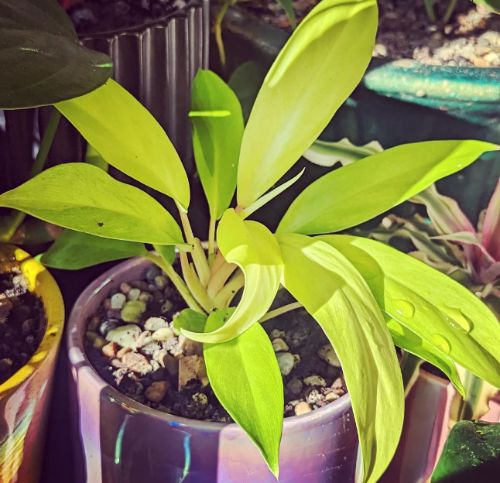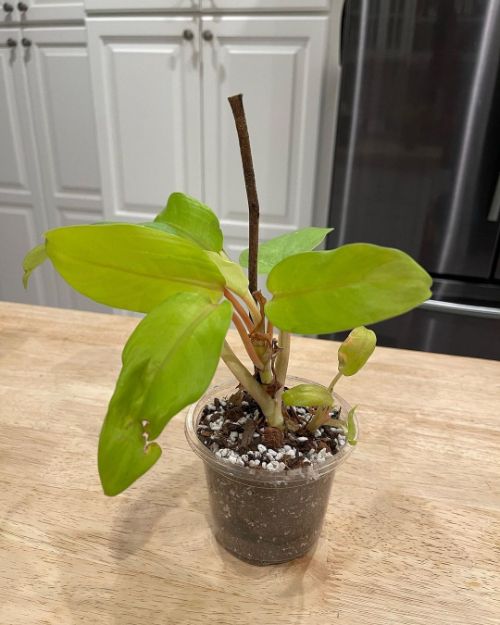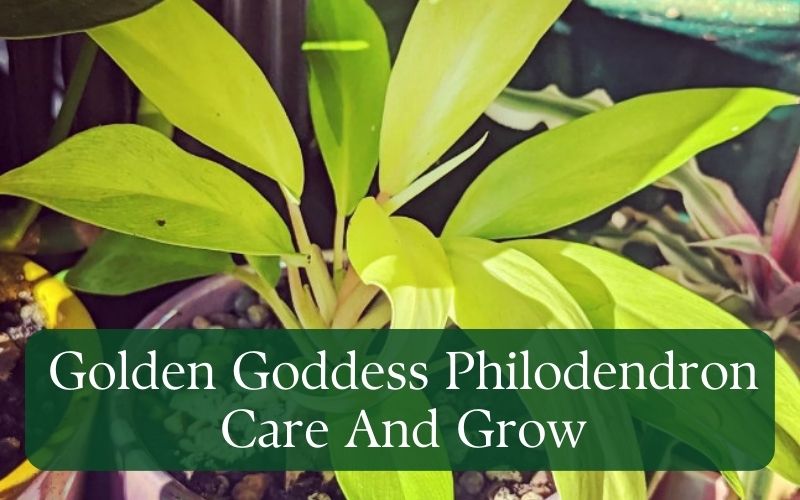If you want to add a beautiful and easy-to-care-for houseplant to your indoor plant fam, say hello to the Golden Goddess philodendron (also known as the golden philodendron or the lemon-lime philodendron).
As it grows, it starts climbing and puts on a show you won’t want to miss. In this article, we’ll cover everything you need to know to grow this beauty successfully. Keep reading to find out how to take care of your Philodendron Golden Goddess the right way in this ultimate care guide.
About Golden Goddess philodendron
The scientific name of the Golden Goddess philodendron is Philodendron ‘golden goddess’. It’s originally from the warm tropical climates of Central and South America. This plant belongs to the Araceae family, and its leaves get bigger and bolder as it ages, especially if you give it something to climb on.
Every single neon-yellow leaf on this philodendron is a total standout. When it’s young, it fits perfectly on a desk or a small window shelf. But as it grows older, it turns into a climber that can reach up to 6 feet tall. Indoors, it can climb and cover an area of up to 10 feet. People love this house plant because of its attractive golden-yellow leaves.

Golden Goddess philodendron care overview
| Botanical Name | Golden goddess philodendron, Malay gold, lemon-lime philodendron |
| Common Name | Philodendron ‘golden goddess’ |
| Family | Araceae |
| Origin | Central and South America |
| Type | Vine |
| Temperature | Temperatures ranging from 65 to 75 degrees Fahrenheit |
| Light | Thrives well under medium to bright indirect light |
| Watering | Allow the top few inches of soil to dry out before watering |
| Humidity | Needs high humidity |
| Fertilizer | Apply a well-balanced liquid fertilizer regularly during the spring and summer |
| Propagation | stem cuttings. |
| Toxicity | toxic to pets and humans |
Golden Goddess Philodendron care
The golden goddess philodendron is not just stunning but a total breeze to grow and take care of. This tropical plant is low-maintenance and thrives whether you keep it indoors or outdoors. So, how do you take care of this beautiful Golden Goddess Philodendron?
Light Requirements
The Golden Goddess Philodendron needs bright, indirect light to grow well. Place the pot in a window that faces east or west so it gets a good amount of sunlight but not too harsh. Sunlight from these directions isn’t too strong or weak, just right.
If you want to place your Golden Goddess in a south-facing window, where the sun hits hard most of the day, keep it a bit away from the window.
Out in the wild, these plants get patches of sunlight throughout the day as they climb up bigger trees. A bit of direct sunlight in the morning and evening is okay, but strong afternoon sun is a total no-go for this plant. The leaves will look pale and eventually get burned with harsh, direct sunlight.
If you want to see shiny and healthy-looking leaves, give the plant the right amount of sunlight.

Ideal Soil Conditions
The Golden Goddess Philodendron needs a potting mix that’s light, rich, and moist but also drains well. Ideally, you should use a commercial potting mix made just for houseplants.
Choose a soil mix that drains well and has some chunky bits for this plant. You can also chuck some worm castings into the soil mix since they work like natural fertilizers. You can use store-bought mixes for tropical plants and mix in some orchid bark chips and perlite.
Don’t use garden soil for your indoor plants. It’s too heavy and often drains poorly. The Golden Goddess Philodendron likes soil that’s sandy but rich. It’s a fan of moist soil, but can’t handle being waterlogged for too long.
Watering
Philodendron Golden Goddess doesn’t like too much water. How much water you’ll need is gonna change based on how hot it is, how humid it is, and how much light your plant’s getting. But here’s a rule of thumb – wait till the top 1 to 2 inches of soil dries out all the way. Any extra water should be draining out from the pot’s holes each time you water it.
The Golden Goddess philodendron can handle a little underwatering if you forget to water it once in a while, but it can’t deal with too much water and root rot. So make sure your plant isn’t sitting in soggy soil.
Try and stick to a regular watering schedule to keep your Philodendron Golden Goddess happy. It likes moist but not wet soil.
Suppose you don’t stick to a strict watering schedule or anything like that. Instead, you should water the Golden Goddess philodendron based on how they feel. You pick up the pot of each plant every week or two to feel how heavy it is. If a pot feels light, you check the soil to see how dry it is. If the top bit of the soil is dry and the pot’s light, it’s watering time
You move the whole pot to the sink or bathtub, turn on the water, let it run through the pot, and out the holes for a few minutes. Do this till the soil’s totally soaked, then turn off the water. After the extra water drains away a few minutes later, put the plant back where it was, just make sure the saucer’s entirely empty to stop root rot. You could also try watering the plant from the bottom.
Temperature Requirements
The Philodendron Golden Goddess likes in temps between 65 and 75 dF (18 to 24 degrees Celsius) and gives your plant a little extra humidity if your house is dry.
When winter hits, move your philodendron buddy indoors to a cozy, bright spot. It can’t deal with frost and super cold temps, so you can either wrap your plant up with garden fleece or bring it inside.

Humidity
The Golden Goddess philodendron likes moderate to high humidity and humidity levels over 50%. Still, it’s pretty chill with the lower humidity levels in your average home. If you want to up the humidity level around your Golden Goddess philodendron:
- You should get a humidistat on the furnace to manage the humidity in our house all winter. You should set it at 35% in the winter and keep the plant away from air vents and chilly drafts.
- To make it feel more at home, place it close to a bunch of other houseplants.
- The best way to up the humidity for your plants is to put a humidifier close by, or pick a naturally steamy room to show them off—like the bathroom, laundry room, or kitchen.
- Prep a humidity tray by filling a tray with pebbles and water. Pop your plant on top of the tray. As the water evaporates, your plant will soak up the needed moisture from it.
- Spraying the leaves often also helps in keeping the humidity levels up. It might get too dry, especially in scorching summers.
Fertilizer
The Golden Goddess Philodendron loves to be fertilizing regularly during spring and summer. Fertilize it with good liquid plant fertilization (1:1:1) and follow what the label says. Best to fertilize it once a month during spring and summer.
Your Golden Goddess Philodendron needs a little fertilizer every 4 to 6 weeks when it’s in its growing phase, usually from March to August. Don’t bother with fertilizing during fall or winter. There are a bunch of houseplant fertilizers you can find, like liquid or granules kind.
You get to pick which one you want, but make sure the NPK mix is right for houseplants.
Be careful not to overdo the fertilizing for your Golden Goddess Philodendron. If you do, the leaf tips can turn brown and crispy, and the growth can get weird. You might also see salt building up in the soil or pot, and the leaves can change color. If you’re unsure, it’s better to underfeed than over-fertilize.
Repotting
In about two or three years, Golden Goddess Philodendron’ll start stretching its stems and show you it’s ready to climb.
You’ll spot baby bumps of aerial roots popping out from the leaf joints. And you know it’s time when seeds start peeking out of the drainage holes at the bottom.
Every time you switch to a new pot, go for one that’s just an inch or two wider than the last one and fill it up with the potting mix we talked about earlier.
Untangle any stuck roots with your fingers, and then put the plant in its new home. Make sure not to bury it deeper than it was in the old pot.

Pruning
Pruning is sometimes needed when looking after a Golden Goddess Philodendron. Your primary job will be to get rid of any dead or yellowing leaves.
Since the golden goddess philodendron is a fast grower and likes to climb, you’ll probably have to prune it at some point to keep it at the right height and make it look neat.
Use a clean, sharp pair of pruning shears or scissors for any cuts along the stem and ugly leaves. You can prune the climbing stems if they get a bit too wild, but try not to do it too often.
You can prune the climbing stems if they get a bit too wild, but try not to do it too often. It can make the plant look fuller instead of taller, but that’s not its thing, so you can only force it for so long.
Don’t prune your philodendron too much and let it do its climbing thing like nature wanted.
It is best to prune in spring or summer when the plant is growing. Any stem cuttings you get when pruning can be used to make more plants to give to friends or family.
Propagating Golden Goddess Philodendron
Propagating more Golden Goddess plants is easier than you might believe. You can take stem cuttings from the plant and root them in water or can also get a stem to root in a pot of soil while it’s still connected to the mother plant.
You can easily make more of this philodendron with stem cuttings. To make new golden goddesses, you do these simple things:
- First off, grab some stem cuttings from your plant. Make sure you use clean pruning shears and get cuttings with around 3 to 4 junctions.
- You gotta cut just below a node. Keep one or two leaves at the top, but don’t forget to leave at least one leaf at the end of the cutting.
- Then, dunk the bottom part of each cutting in water, but make sure the junctions are underwater and the leaves stay dry and out of the water.
- Find a spot with a fair bit of a lot of indirect sunlight. You’ll start seeing roots grow in about two weeks. Change the water weekly. Once the roots get about 1 to 2 inches long, it’s time to move the cutting to the soil.
- Grab a pot, fill it up with well-draining soil, and get it wet. Carefully pull the cutting out of the water and stick it in the pot, then give the plant a good watering.
- Put the pot back in a place with decent light. Keep the soil wet for the first few weeks to help the new roots get used to their new digs.

Golden Goddess Philodendron Common Pests & Plant Diseases
While Golden Goddess Philodendron is pretty chill to care for, sometimes issues do pop up. Let’s have a look at some of these problems.
Pest
- Spider mites, which can wrap old and new leaves in thin webs as they suck out plant juices
- Fungus gnats, a pesky pest that feeds on the fungus spores found in potting soils;
- Mealybugs, which look like tiny balls of white cotton on stems and leaves.
How to fix: Treat any bug-infested plants by spraying the leaves with rubbing alcohol or bug spray depending on which bugs you’re dealing with.
Bacterial Leaf Spot
Bacterial leaf spot causes leaf spots that look soaked, especially on the older leaves.
They start out red and turn black over time.
How to fix: To nip these symptoms in the bud. Cut off the sick leaves and stems and get rid of them. Remember to not water the leaves when you water the plant.
Leaf Tip Curl
When your plant gets a leaf tip curl, the leaves turn brown and curl upwards. The roots die off eventually. Using super-rich soil or too much fertilizer is the leading cause of this disease.
How to fix: Take the plant out of the pot and check its roots. Cut off the dead roots and use a based fungicide.
Root Rot
Root rot is a pretty common problem in almost all Philodendrons. Overwatering is the main cause of root rot.
How to fix: To avoid and handle the problem, let the soil dry and get rid of the dead and black roots, if any. Stop fertilizing for a month and switch the soil to fresh, well-draining soil.
Leaves brown, crispy
Leaves with brown, crispy edges are a sign that your plant is thirsty. Usually, it needs more regular watering and increased humidity to stop further browning.
How to fix: Try moving your plant to a more humid spot and giving it good water.
Droopy Leaves
If you spot that the leaves of your golden goddess philodendron are drooping, it usually means that the plant is begging for water. After a good watering, the leaves should perk back up within a few hours. However, if they don’t, this can be a clue that the plant’s roots may be dried up—they can’t soak up the water to hydrate the plant.
How to fix: You’ll need to cut the stems of the plant to encourage new roots to grow.
Golden Goddess Philodendron FAQs
Q: How Do You Look After a Golden Goddess Philodendron?
A: The Golden Goddess Philodendron prefers warm, bright, and humid places. Keep it somewhere bright that gets indirect light. Give it good water to keep the soil evenly damp and let the soil get a bit dry between waterings.
Q: Is the Philodendron Golden Goddess a Climber?
A: Yep, the Philodendron Golden Goddess is a climbing plant that acts like a vine in the forests, where it grabs onto other tree branches.
Q: Is the golden goddess Philodendron hard to find?
A: The golden goddess philodendron is a bit of a rare gem among the philodendron varieties, but it’s usually not too tricky to find at garden centers and plant shops. If you can’t find it, online plant sellers usually stock it.
Q: How big does the golden goddess Philodendron get?
A: Indoors, the golden goddess philodendron maxes typically out at around six feet tall. But, this can only happen when the plant has something like a moss pole or trellis to climb.
Q: Is the golden goddess philodendron the same as the lemon-lime philodendron?
A: Golden goddess philodendron and lemon-lime philodendron are two names for the same dude, which is sometimes also called Malay gold.
Conclusion
Caring for your Golden Goddess Philodendron isn’t complicated with the right knowledge. Follow these guidelines and your plant will thrive, adding lush greenery to your spaces. Remember, at FamiPlants, we are always here to guide you on your plant care journey, ensuring your Golden Goddess Philodendron thrives.

